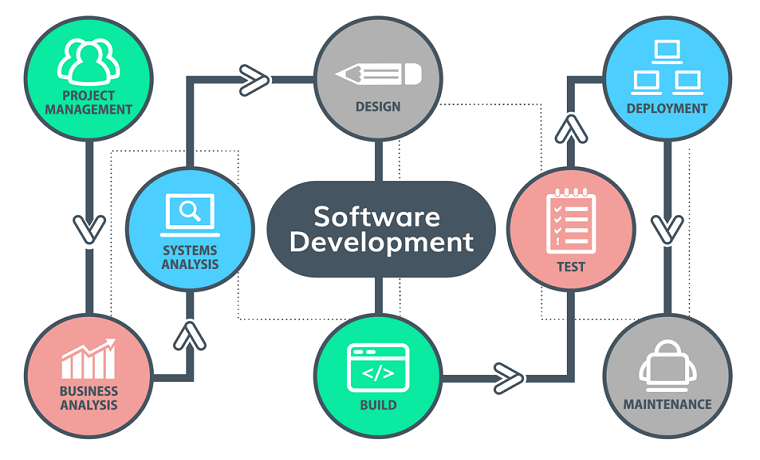Our lives are highly influenced by the software we use. Whether we read an online magazine, shop online or chat with a friend, software plays an essential role in making all these actions possible. But the product we access with a simple click or touch requires the hard work of numerous experts to make it come to the final form we are presented with.
The process of building a good software includes numerous phases that provide the correctness and quality of a good-working software. All the following phases are important, if one of them is wrongly operated, the entire life cycle is based on a mistake, and the final product will contain flaws and bugs.

Here are the core phases of software development
Brainstorming Phase
In this step, the requirements for the software are sourced. Communication is taking place between developers, stakeholders and users to understand what features the final product must include. During this stage it’s important to find out the answers to some questions like:
- Who will use the product?
- What type of data goes into the software?
- What type of data the system will return?
Once the requirements are noted and the questions answered, they are analysed and a requirements specification document is created. The information gets to the development team that can proceed to the next level, designing the product.
But before starting to design the software, the CEO and the team members will carry out a feasibility analysis. It will help them understand if the project will be successful by evaluating technical and economic factors. All members of the team will estimate the time they will spend to complete their tasks, and the resources they need. If the team concludes that the product has chances to succeed, they will start designing it.
Design Phase
As we all know what is a dedicated team and its importance in software development. A professional and dedicated team will design the system according to the requirements specification document. Both designers and analysts will collaborate during this phase. The design of the software assists in the specification of the hardware required to run the system, in other words the deployment. According to the type of software, the deployment tools will be determined because they are crucial to producing functional software.
This phase also decides the general system architecture, the software models needed to be developed, and their connections. It is also the moment when the development platform is chosen, and the user interface and user experience are designed.
Coding Phase
During this stage, software developers start programming. They will do more than coding, they will also perform module or unit testing to identify possible issues as early as possible. Every programmer has their own task for coding; they will be responsible for delivering a functional module. It’s the most time-consuming operation because it implies multiple sub-phases.
Some companies prefer to outsource programming activities and to collaborate with companies specialised in software development. Many times the reason is that the company does not have the needed skills and resources to complete the coding stage of developing software.
Testing Phase
Once the coding stage is complete, the team can move on to the next phase, testing. This step is essential to evaluate the product against the parameters available. The role of testing is to expose potential issues the product may have and to find effective ways to correct them.
During the previous step, developers themselves have performed module or unit testing, during this phase they will focus on integration testing. The relationship and interaction between all individual and external systems are tested. Once the integration testing is completed, the validation verification will be performed. The end product will be tested according to the requirements of the UI/UX design, from an end-user point of view.
Deployment Phase
Once the product is ready for being launched, the deployment of the software ensues. This procedure has the role to make the product readily available for use in a certain environment. Depending on the choice of the developers, it can be performed with the help of automated deployment tools or manually.
The deployment phase includes numerous other stages.
- A professional team will install the software and will perform multiple tests to prepare it for the final installation. They will include instructions on how the system will be operated and used at its maximum performance.
- Implementation of programming is done in all locations; the system is pushed in all regional sites and computer systems.
- Once the code is deployed to all computer systems, the process of transferring the ownership to the client starts. The client can now access all features of the software and they are instructed on the procedures they have to do to maintain the system’s functionality.
The Maintenance Phase
The first release of the system is followed by releases of upgraded versions of the product. Maintaining it functional is equally important with developing it. It will keep it healthy to face the changing business and technical environments. Once the development process is complete, software maintenance starts, and it’s a quite broad activity. As long as the software will be functional, software maintenance is required.
Software maintenance services categories
Preventive – preventing the software from upcoming vulnerabilities is vital, it helps the client avoid losing valuable resources
Corrective–detecting errors and identifying the right solution for solving them will make the software work more efficiently
Perfective–upgrading all the abilities, functionalities and elements of the system to improve its operations and functionality
Adaptive – modifications in the system are done regularly to make it compatible with the requirements of the users.
IT is one of the most updated markets nowadays. New technical advancements are introduced daily, and the solution to keep up with the latest business and technical requirements is to perform maintenance management.
In the present competitive internet world, people want to design software for business and not only. The purpose of the software is to solve the needs of the users, and the role of the development process is to create an error-less product for the clients, and to fulfil all the requirements of the users.

